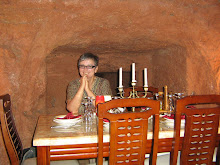

Summer changed my routines, stirred me around a little, made me restless. That's my excuse for leaving the blog for six months.
Now it's winter and the scaffolding of my life is slipping back into place. Lunchtime concerts, weekend walks, writing my blog...
And there is a new feel to Valletta, a new liveliness, more people strolling the streets and they're not just tourists trotting behind a bright umbrella. What are they here for? It's not the restoration work that seems to be happening everywhere, nor the new festivals like Ziguzjag, nor the Christmas decorations (same as last year except for the gorgeous glass ball tree that heads up the post) nor the instant trees with seating down Merchants street. There's an excitement, something is happening in Valletta.
Yesterday I woke to a beautiful sunny day. The harbour entrance was calm and the new footbridge to the breakwater almost glowed in the morning light. (I tried to put a picture here but it insisted on going at the top)
I decided to go out for the Sunday papers and then wander down for the open day at the Museum of Fine Arts.
Something was happening in St George Square. The fountain was off, there was a blow-up gateway where Republic street enters the square and a crane was holding a big screen announcing the President's fun run. Even more startling was the sight of Queen Victoria on her plinth as always but in solitary splendour - no cafe table, chair or umbrella in sight. I have never seen her square denuded of hospitable clutter. The surrounding buildings including the National library and the old sun calendar above Cordina's stood out magnificently.
As I strolled on down Republic street, a sense of gathering hung in the air - band players were arriving in ones and twos with their instruments tucked under their arms, people were leaning cautiously over the barriers to touch the glass balls of the Christmas tree to make sure it wasn't plastic.
At the museum of Archaology, I decided to call in and see the exhibition of Spanish Treasures from the Khalili collections, Magic Metal. This remarkable collection of Damascene metal objects is set up in the upstairs gallery and the accompanying book, Ornament and Malta, An Introduction, draws together the Moorish and Spanish influences on Malta's decorative arts.
I was on my own at the exhibition apart from the young woman security guard who engaged me in conversation and encouraged me to continue my stroll to the Museum of Fine Arts as well as taking in the War museum (another day perhaps?).
I was certainly not alone as I came back out onto Republic street! The walkers in the President's Fun Run turned the street into a purple river, chattering and swirling around the silver Christmas trees, pushchairs, wheelchairs, dogs making little eddies in the stream. I stood on the ramp outside the museum for several minutes before plunging in and walking against the current up towards South street to turn off to the Museum of Fine Arts. I rejected the idea of crossing the stream to go to St James Cavalier and catch their 11.00 am Sunday concert.
The air of something about to happen hung about the museum as well. There was the sound of a piano in the courtyard and as I went up the stairs I could see children drawing on a large board set up on the mezzanine. I glanced at the familiar Mattia Prettis and spent a bit of time browsing the book stall for bargains. Then went down to the basement for the Paul Caruana exhibition, Short Stories, a charming, nostalgic look at growing up in Valletta.
Back in Republic street, the bands were playing and walkers were dispersing into side streets and cafes. My pace had slowed to an amble now, partly due to my sprained ankle but mostly because I really wanted to linger with this new Valletta feeling. In St George's square, children were gathering around Minnie mouse demanding hugs.
I turned the corner for home, my backpack heavy with Sunday papers and reduced price art books. Sweet Sunday in Valletta...






















